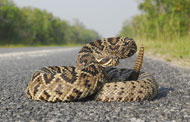Description:
To reptile enthusiasts, this is the king of the rattlesnakes. This dangerously venomous snake is usually rather slow moving, but can hurry along if it chooses. It often crawls slowly in a straight line (rectilinear movement). If startled or threatened it will coil, elevate its head and neck into a striking S and either stand its ground or slowly back away, often while rattling furiously. Diamondbacks can swim, but while doing so usually keep face and rattle well above the water surface. The white edged black diamonds contain an olive center. This contrasts starkly against the gray ground color. A 50 to 75 gallon capacity terrarium will suffice for one or a pair of eastern diamondbacks. The substrate should be dry and may consist of folded newspaper, several thicknesses of paper towels, aspen shavings or cypress shavings. A hide box and visual barriers should be present in the cage. A water receptacle must be present. The water must be kept fresh and clean. Daytime illumination should be provided. A room temperature of 76 to 83 degrees Fahrenheit is a suitable temperature for the terrarium. Nighttime temperatures of about 70 degrees are adequate. A daytime hot spot of about 92 to 95 degrees should be provided by a basking lamp. If kept merely as a pet, the eastern diamondback may be kept warm and active all winter long. It will usually eat more sparingly in the winter. If you intend to breed these snakes, they will probably require a 90 day period of cooling (but not necessarily of dormancy). The eastern diamondback preys preferentially on rabbits and rodents, but also eats ground dwelling birds. Most captives, whether neonate or adult, readily accept rodents. A litter may contain 20 babies but between 4 and 12 in a more usual number. Neonates are 12 to 15 inches in length. These snakes may be moved with either a snakehook or a clampstick.
Habitat:
This is a snake of the open pine woods, pine-palmetto scrublands and scrubby sand ridges.
Range:
The documented range is from southeastern North Carolina south to Florida (including the Keys) and west to extreme eastern Louisiana. The eastern diamondback has now been eradicated from many portions of its one time range and is rare in many others.
Scientific Name: Crotalus adamanteus
Species Group: venomous
Family: Viperidae
Size: Today’s eastern diamondbacks are adult at 3½ to 5½ feet in length. In bygone days 6 and 7 footers (the record is 8 feet) were not uncommon.
Level: advanced
Weight:
Dangerous: No


